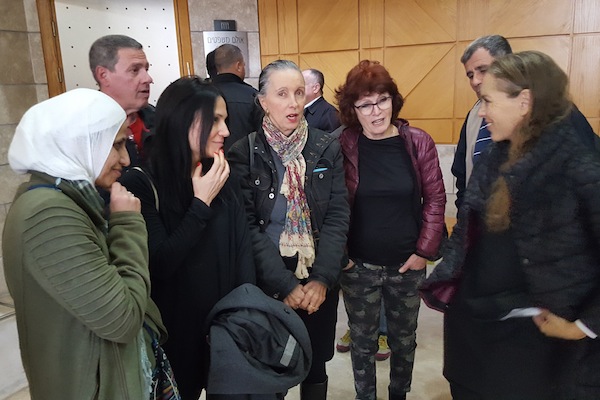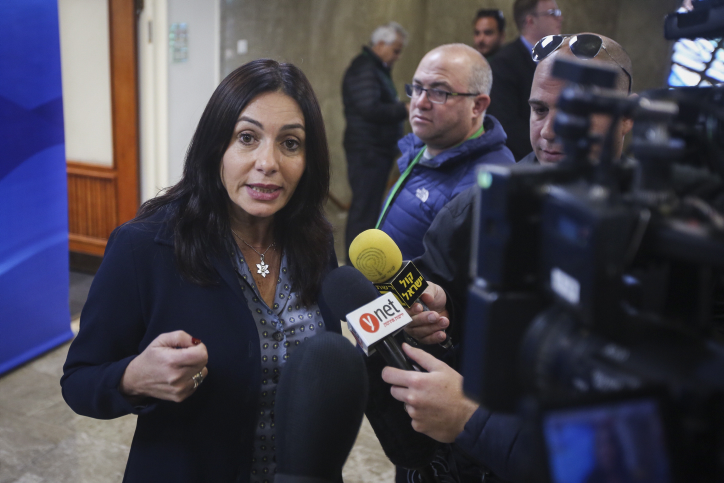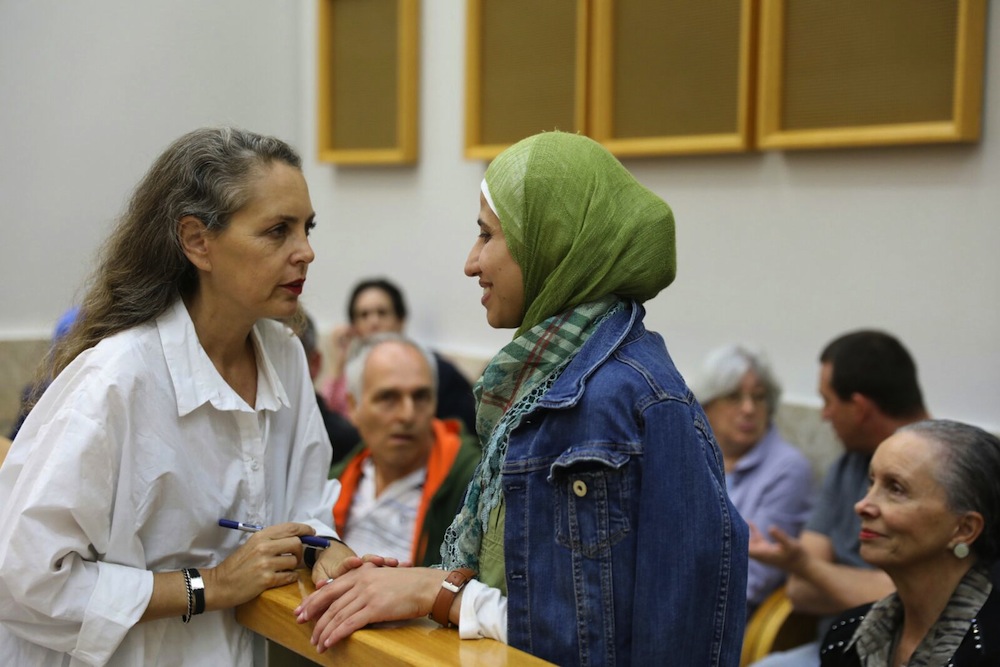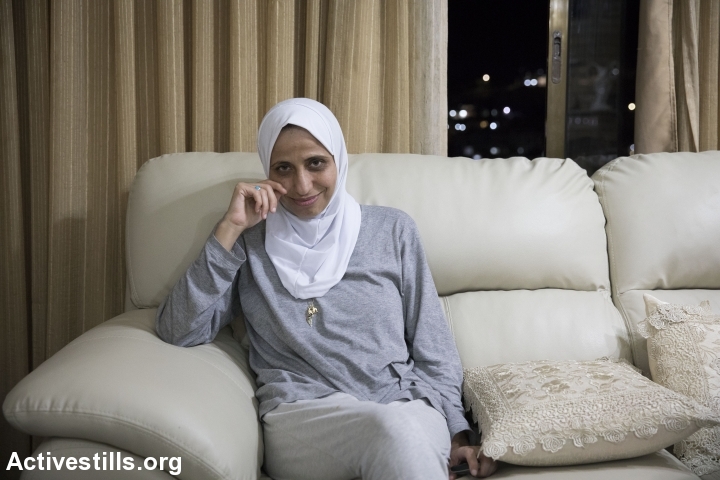By the time a verdict is handed down in her case, Dareen Tatour will have lost over two-and-a-half years of her life to prison and house arrest.
By Yoav Haifawi

Like a cartoon character who runs over a cliff but continues to run in the air, or Achilles who thought he could pass the tortoise easily, but each time he got close, the turtle moved a bit further away, so is the trial of Dareen Tatour, a poet who has been detained since October 2015 — defying gravity, looking like it will never end.
After the last witness testified back in April 2017, Judge Adi Bambiliya-Einstein decided that the parties should submit written summaries within three months. In September, Tatour’s defense attorney, Gaby Lasky, asked to present new evidence, and the issue was brought before the judge on November 15. On that occasion, the judge accepted a request by prosecutor Attorney Alina Hardak to supplement the written summaries with oral closing arguments. After several postponements, the court scheduled the hearing for Sunday, February 18.
The prosecution’s extra show
The prosecution submitted 43 pages of written summaries. The defense managed to shorten its arguments and squeeze them into 83 pages. The initial justification had been the new evidence.
And yet there was not much new evidence.
The prosecution convinced the court not to accept as evidence a screenshot from Tatour’s Facebook page showing that she initially published the profile picture with the caption “I am the next martyr” in July 2014, as a response to the murder of the teen Muhammad Abu Khdeir. It was rejected on technical grounds — the absence of a witness corroborating the authenticity of the image.
The second piece of new evidence related to the publication of a video accompanied by the lyrics of Tatour’s poem, “Resist My People.” The defense brought evidence that the same video was later posted by Israeli Culture Minister Miri Regev on her own Facebook page. That no legal steps have been taken against Regev, the defense argued, constitutes proof of discriminatory prosecution. The arguments on this matter lasted less than a minute, out of an hour and a quarter of the prosecution’s closing arguments.

On the other hand, the prosecutor took advantage of the closing arguments to repeat that which she had already detailed at length in the written summaries. She tried to present the poem, “Resist My People,” as part of the wave of attacks by Palestinians in October 2015.
The defense insisted that the poem is a legitimate expression of protest, which speaks about the occupation’s violence against innocent Palestinians. The defense based its arguments on specific events that were mentioned in the poem: the children who were burned; Hadeel, who was shot; the settler’s robbery; and the violence of the army’s special undercover units.
The prosecutor focused on what she thought was clear to every “average person”—the Israeli worldview that sees every Arab, and especially whoever opposes the occupation, as a dangerous terrorist. The prosecution, therefore, screened gory videos of Palestinian attacks, under the pretext of checking the skill and objectivity of the defense’s translator. This time, to refresh the judge’s memory, the prosecutor began to read aloud in court a list of attacks by Palestinians that took place in October 2015. Defense Attorney Gaby Lasky objected, which the judge accepted — a rare occasion in this court.
According to the prosecution, the publication of the photo “I am the next Martyr” was part of a systematic pattern of encouraging suicide attacks. The fact that the picture was first published in response to the burning of young Abu Khdeir, of course, should have been conclusive proof that Tatour speaks of the martyr in the sense of a victim rather than an attacker.
However, as previously mentioned, the prosecutor managed to have that new evidence stricken. Now she wanted “to prove” that this image was first published in October 2015. During the trial, the prosecution claimed (and Tatour consistently denied) that this picture first appeared next to the picture of Israa Abed, who was shot at the central bus station in Afula on October 9, 2015, after she was wrongfully suspected of intending to carry out an attack. The prosecution used this false claim as proof that it couldn’t have been published by Tatour earlier. On the basis of this circular argument, the prosecutor even dramatically declared that Tatour was “lying brazenly,” which led to another objection by Lasky.
An important part of the defense summaries focused on the importance of preserving freedom of expression, especially freedom of political and artistic expression. For this purpose, the defense quoted not only many legal precedents, but also international conventions to which Israel is a signatory. Concerning one of the cited documents, a joint declaration of 57 countries issued in September 2015, before the 30th session of the UN Human Rights Council, which relates to the freedom of artistic expression, the prosecutor claimed that it is not legally binding and that, in fact, Israel’s participation in this declaration has no practical value. She even said that this was the position of the State Attorney’s Office Department of International Law. Lasky requested to see this legal opinion.
Was the prosecution authorized to file the indictment?
The indictment accuses Tatour of two crimes: incitement to violence and support for a terrorist organization. These two articles, by nature, restrict freedom of expression, and therefore indictments under these articles require the approval of the attorney general. In practice, the prosecution only submitted to the court approval from the attorney general for prosecuting Tatour for “incitement to violence.”
It is worth noting that the excessive sensitivity to freedom of expression in Israel’s legal system is applied mainly to the freedom of expression of settlers and other anti-Arab extremists. Therefore, in cases of this type, the defense often quotes cases of right-wing activists who were acquitted despite serious violent statements. The judges, for some reason, have no difficulty telling the difference; when the accused is Arab, they use entirely different criteria.

Lasky argued in her written summaries that in the absence of the required authorization, the part of the indictment that deals with support for a terrorist organization should be considered null and void. She cited precedents of indictments that were dismissed due to lack of such authorization, and showed that such decisions can be made even in the late stages of a trial.
In response to these claims, the prosecutor drew a rabbit from her hat. She presented to the judge a letter which, she claimed, proved that a deputy state attorney approved indicting Tatour for supporting a terrorist organization. Lasky was furious at how the prosecutor suddenly presented a document that had not been submitted to the defense as part of the investigation materials. The prosecutor explained that this was an internal correspondence with the State Attorney’s Office that was not part of the investigation materials. The judge gave Lasky the letter so she could look at it, but the prosecutor snatched it from her hands, claiming Lasky was not allowed see it.
For a few minutes, a dramatic argument took place between the prosecutor and the defense attorney.
Lasky argued that the accused could not be convicted on the basis of materials she had not been allowed to see. The prosecutor gradually withdrew, saying she was ready for Lasky to see the letter but not photograph it. The judge made it clear that if the letter was indeed attached to the case, it would be scanned and accessible for the defense. The prosecutor sought to consult with those responsible for her, and argued that the entire issue of the necessary approval is an internal procedure that does not oblige her to present approval to the court, and that the court should be satisfied with her declaration that the indictment was submitted with the necessary authority.
Finally, the same letter was presented again to the judge. It was clear that it was not actually an authorization by the attorney general. The judge announced that it would also be given to the defense, which would probably refer to it in her response to the prosecution’s summaries.
Five minutes
The hearing was supposed to last an hour and a half. Starting 15 minutes late, after an hour and a quarter of the prosecutor’s summaries, it was already 10 o’clock. The other litigants scheduled to appear before the same judge were already waiting in the courtroom. The judge told Lasky: “You have five minutes to summarize.” I still don’t know whether she meant this seriously or in jest.
Lasky used the few minutes she had to object to the whole procedure of the supplementary summaries. She reviewed the sequence of events, how it was decided that the summaries would be delivered in writing, followed by the verdict, with no room for further summaries. The nature of the criminal proceeding, she said, citing from legal textbook, is such that the prosecutor summarizes first, then the defendant is given the right to the last word. If there was justification for supplementary summaries because of the additional evidence, that is not what happened. Lasky demanded to cancel the entire procedure.
In the event that this request is rejected, Lasky explained that she cannot respond without preparation and examination of the prosecution’s new claims, which include references to different court rulings and minutes of Knesset deliberations designated to clarify the legislator’s intention. She said she would prefer to submit a written response.
The judge and the audience
This prolonged and absurd trial always leads to new surprises.
At a certain stage, during the stormy debate over the submission of the letter ostensibly proving that the indictment had been approved, journalist Ofra Yeshua-Lyth, who was sitting next to Tatour, remarked out loud: “Write it down, it was not recorded in the protocol.”
The judge stopped the hearing and asked: “Who said that?”
There was silence in the courtroom and then Ofra said “I,” already prepared to be thrown out of the hall for disturbing the hearing.
However, in lieu of the expected scolding, the judge told Ofra that she should not worry and that the trial was conducted with great fairness.
Since discussion between the judge and the public had been legitimized, Ofra added that she had examined the minutes of the trial and that not everything that was said in the courtroom was recorded in them.
The judge patiently explained her policy regarding writing the protocol: only what was of legal value was recorded. When some of the audience repeatedly argued that important things were not recorded, the judge replied that if something important was missing in the protocol, the defense could file an official request for its amendment.

Toward the end of the hearing, another activist, Bilha Golan, remarked: “this is a political trial.” In response the judge resumed the rare dialogue with the public. It was, in essence, a lecture by the judge — not to be mentioned in the protocol, of course — designed to prove that this was a fair process whose sole purpose was to enable her to judge objectively, according to the facts presented to her.
“Everyone is here to examine the truth,” the judge claimed. She explained patiently – again – and at one point even said she was talking to us as she sometimes spoke to her children. At one stage, she even claimed that we, Tatour’s supporters, were hurting her. According to her, we, by our one-sided approach, made Tatour feel that the process was unfair and that she had been wronged!
Activist Hana Safran took the opportunity to remind the judge that while the trial was being held, Tatour’s life had been put on hold for more than two years. Even if she is eventually acquitted, she has suffered greatly – and no one can undo that suffering. The judge replied that the matter of house arrest was not her responsibility, but was rather determined in another proceeding by different judges. Perhaps this judge is unaware that the judge responsible for Tatour’s detention rejected the latest request to revoke her house arrest — without even scheduling a hearing.
What next?
As expected, the judge rejected the defense’s objection to the proceedings.
She told Lasky to choose between summarizing on the spot, and promised that she would stay until the middle of the night to hear her arguments, and presenting written summaries. In the end, she gave Lasky seven days to submit a written response.
Only after receiving these summaries will the judge set a date for announcing the verdict. Until it is given, Dareen Tatour will have lost more than two-and-a-half years of her life to prison and house arrest.
Yoav Haifawi is covering this trial and more on his blog, Free Haifa. A version of this article was first published in Hebrew on Local Call. Read it here.
